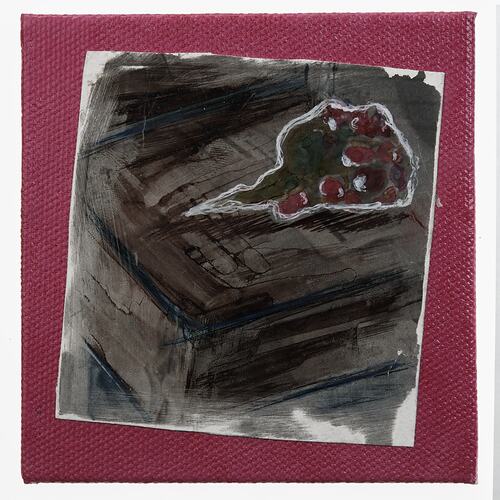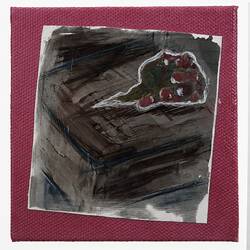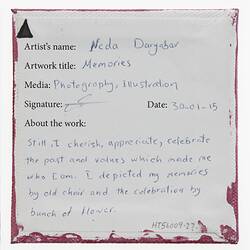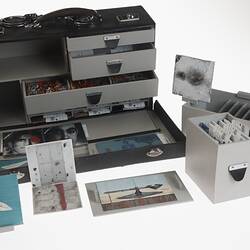Summary
Artwork entitled 'Memories' created in 2015 by Melbourne-based Iranian refugee, Neda Daryabar. It is part of 'Attache Case', a collective artwork co-ordinated by Peter Burke in 2015.
Artist statement provided by Neda in 2021:
'Neda Daryabar is a freelance artist and a graphic designer with years of experience as an industrial designer. In her artworks she follows the vision of fostering humanity, hope and dignity for people, especially those with vulnerability. In 2013, she discovered the Heartlands exhibition was an ideal platform for expressing her views on an international social justice issue she feels passionately about, for which she won the Parks Victoria Artist in Residency Prize. For the survivor of torture and trauma, PTSD is a common syndrome that affects daily life. For many refugees life is the experience of reaching for unattainable peace, as flowers in a dream looked chair if yet they are not recovered. In my picture, I aimed to depict uncertainty by the use of grey scales.'
This collective artwork, entitled 'Attache Case' (HT56009), was created by Melbourne artist, curator and lecturer Peter Burke in 2015 as part of an international touring art installation, 'Low-Cost Diplomatic Bag', auspiced by the Spanish Embassy, and curated by Nilo Casares and ArtEx Madrid. It travelled to the Spanish Embassies in five countries, including Australia, in 2015-2016 (one venue included Immigration Museum, Melbourne). 'Attache Case' is comprised of a re-purposed doctor's medical case which opens to reveal small drawers containing 41 individuals' miniature artworks representing 21 refugees from Afghanistan, Vietnam, Poland, Colombia, Sri Lanka, Iran, Egypt and Iraq.
The artworks inside the case are acrylic and oil paintings and collage works on canvas board and copper. Many artworks have handwritten descriptions on paper by the artists on the reverse. The collection also includes a video about the project by César Espada produced in 2015.
Physical Description
Photograph & acrylic on canvas board. Old couch with a bouquet of flowers drawn on it.
Significance
'Attache Case' is a collective artwork created in 2015 in response to an invitation by artist, Peter Burke, to a number of asylum seekers and refugees in Melbourne to express their experience visually. The refugees and asylum seekers (some in detention at the time of the project) who produced the artworks came from diverse countries including Afghanistan, Vietnam, Poland, Hungary, Colombia, Sri Lanka, Iran, Egypt and Iraq. They explore diverse themes relating to detainment, immigration, border security policies, bureaucracy, and mental health.
The artists convey thoughts and feelings about freedom, opprtunities, life in Australia, resettlement, optimism, despair, grief, hope, fear and anger and the consequences of living in limbo. These refugee and asylum seeker's voices, concerns, and personal perspectives are not often publicly expressed and more often manipulated by media and politics or silenced in their community.
This complex artwork contains a diversity of cultures, genders, experiences, artistic styles, and responses. The oil and acrylic paintings are objects rich with symbolic meaning - both as a part of a luggage item reminiscent of the migrant experience, as well as a traveller's borderless container (representing migration, diplomacy, policy and bureaucracy) of voices that speak to the issues that are at the heart of the asylum seeker situation and debate.
More Information
-
Collecting Areas
-
Artist
-
Creator
-
Inscriptions
Reverse side [handwritten]: 'Still, I cherish, appreciate, celebrate'/'the past and values which made me'/'who I am. I depicted my memories'/'by old chair and the celebration by'/'bunch of flower.'
-
Classification
Cultural identity, Ethnicity - creative practice, Mixed media
-
Category
-
Discipline
-
Type of item
-
Overall Dimensions
100 mm (Length), 100 mm (Width)
-
Keywords
Refugees, Artists, Artistic Practices, Artworks, Immigration Debates, Immigration Selection, Immigration, Luggage, Detention Centres, Activism, Politics, Ethnic Groups, Iranian Communities, Iranian Immigration



